SEO
5 Tips To Improve Your Content Strategy
Every digital marketing strategy relies on a number of elements to ensure its success.
For a holistic campaign, you’ll need to consider how you’ll approach email marketing, paid search, social media posts, and reputation management, just to name a few.
And while these are all important, there’s one thing that takes precedence over everything else: content.
Regularly posting new, insightful content is a proven way to improve brand awareness, build trust, engage with your audience, and drive action – but just any old content isn’t going to do the trick.
You need high-quality content that serves a purpose. And to do that, you need a strategy.
A content strategy, also known as a content plan, is a collection of tactics used to create, implement, and manage marketing information, materials, and collateral. You can think of it as your marketing battle plan.
And like any good plan, it needs to be detailed and comprehensive, down to what type of content you’ll be posting, when and where you’ll be posting it, and who is responsible for each element.
Here are five things you can use to take your content strategy to the next level.
1. Think Like A Publisher
You know your brand inside and out, which is a good thing, but it also comes with some issues.
For one thing, because you’re so familiar with it, it becomes easy to take certain knowledge for granted, often without even realizing it. Unfortunately, this can easily lead to frustration for your audience.
The simplest way to eliminate that is to think like a publisher. In other words, identify what your audience is looking for and find content to address it. Here are some tips for doing just that:
- Build your content team. You have a lot of expertise in your organization already. Use it. Your team could include marketers, product team members, PR specialists, customer support reps, and IT.
- Establish roles and responsibilities. Everyone on the editorial team should have a specific role in creating the strategy and delivering content. Make sure everyone knows what is expected of them at each step of the creation and management processes.
- Build workflows. Write out exactly how your process works to ensure everything goes through the correct channels for approval. This may include looping in brand specialists, executives, or the legal team.
- Gather feedback. Too many businesses neglect social listening, which is a mistake. You should be actively taking part in the conversations customers are having about your brand. It’s also a good idea to keep track of trending topics, which can provide opportunities for your brand.
- Unify your digital efforts. General marketing and paid media should work to mutually reinforce one another. Partner with your paid media team to ensure your message is consistent and identify places to amplify effectiveness.
- Invest in the right CMS technology. Using a quality content management system (CMS) lets you put the latest technology to work for you. Platforms like WordPress, Shopify, and Squarespace can greatly simplify your workflow and help you manage the entire process from conceptualizing to publication. With the right CMS, you can manage your content across channels without needing to write a single line of code.
2. Make Sure Everything Fits Into Your Sales Funnel
Conversions are the name of the game. In most cases, this means sales, but it can also be clicks, newsletter signups, or any other marketing-specific goal you can think of.
There’s a lot more to content marketing than just sharing a viral video from your office, a blog post on the state of your industry, or linking to an infographic you’ve created.
Yes, it is those things, but it’s also about telling a story. It needs to have an emotional hook that helps change a target’s actions, thoughts, or feelings about your brand. And search is just one small piece of that.
All your online and offline marketing needs to align with your brand narrative and correspond to a step in your sales funnel.
That means that all your content – whether it’s a social post, a photo, a new blog, or even a press release – is important. And it all needs to work together to move your targets further along the sales journey.
And successfully accomplishing this means having a rock-solid strategy before you get started.
3. Refine And Document Your Editorial Process
Whether you’re creating all your content yourself, using a team of people, or outsourcing it to freelancers, it’s important that every piece of content goes through the same editorial process.
The first step to this is evaluating your process. Is everything being looked at by multiple sets of eyes for mistakes, typos, and the like? Sometimes it’s difficult for writers to spot their own mistakes.
Refine your process and then document it with detailed step-by-step instructions. There should be absolutely no confusion as to where a piece of content is in the creation process, what’s performed at that step, and what will happen next.
Be sure to always keep your brand in mind. When deciding on content, don’t neglect the fonts, images, and tone your audience has come to expect from you.
If your tone switches from business professional in one piece to casually familiar in the next, it will leave your audience confused.
Additionally, you want to make sure all your content adheres to your narrative. Make sure every content creator is familiar with things like:
- Positioning – your brand narrative should include the pillars your content is built upon.
- Your values – what issues are important to your brand? (civil rights, ecology, etc.)
- Perception – what does the media say about your brand? What about the community?
- Audience Interests – what are your customers talking about when they’re not interacting with your brand?
- Historical Performance – what type of content has traditionally worked for you? What hasn’t?
- Search Behavior – what are your targets searching for? What phrases are they using?
- Customer Support – what are the recurring support issues you keep hearing from your customers?
Once you’ve identified your brand narrative, it will be a lot easier to craft an effective content strategy and change customer behavior, whether that means closing more sales, repositioning your company, or changing the way customers think about your brand.
Make sure you invest in properly training your team on this new process.
And because there’s always room for improvement, you’ll want to have regular refreshers and continuing education programs built around the latest best practices.
4. Review, Refresh, Replace
Nothing lasts forever, but if you can create the type of content that will have a long shelf life, you’ll be able to generate traffic, clicks, and interaction for months or even years. Other pieces will burn brightly for a short period of time.
It’s up to you to identify what needs to be removed, what should be replaced, and what needs just a minor refresh.
Review your existing content to see what’s still relevant and what needs to go away. If you use stats or link out to other content, make sure you’re verifying these on a regular basis.
Some content, known as evergreen content, will continue to be relevant for a very long time. It’s not something you can set and forget, but it does require considerably less upkeep than trending topics.
How do you figure out what type of videos, blog posts, and how-to guides will stay relevant? With research, of course.
Go through your existing traffic, analyze your competition, and check out industry resources.
What type of topics keeps popping up again and again, regardless of how long ago they were published? Use your keyword research tools to find words and phrases with high search volume over a long period of time.
Either completely avoid news, trends, or technology that could be vulnerable to replacement (that piece on PlayStation 5 might be hot right now, but it’s not going to generate much traffic once PlayStation 6 hits the market) or create it with the understanding that it will have a shorter shelf life.
Choose visuals that are appropriate and less apt to look outdated.
Most of all, make sure it’s useful. If you have a blog post offering a step-by-step guide to riding a unicycle, people searching for information on getting started with a one-wheeler will find it just as relevant in 10 years as they do today (barring some massive change in unicycle technology, that is). Many types of educational content can stay relevant for a long time.
And once you have a good piece of evergreen content posted, keep promoting it. As long as it’s still relevant, it will still generate clicks.
5. Use Your Network
Your content strategy should include more than just your own domain.
Guest blogging is a great way to increase brand awareness and generate backlinks, which will help both your traffic and SEO ranking.
Additionally, if your guest post is on a site your audience trust, it will automatically lend you authority and credibility in their eyes.
Use your connections to find opportunities to cross-promote your brand. Reach out to industry sites and influencers to build a mutually beneficial relationship.
You can use platforms like social media to capitalize on and enhance this, so include this in your content strategy.
Share not just your own content and blog posts, but those from other people in your sphere. You probably don’t want to link to direct competitors, but anyone on the periphery is fine.
Be sure to tag publications, authors, and people mentioned in the article.
Does your industry have popular events, conferences, or trade shows? This is a great place to generate exposure and promote your content.
Run a booth, give a speech, or just have someone on hand to pass out business cards and literature. Not only does this give you a chance to increase exposure, but it also provides opportunities to link back (and therefore generate traffic) to your digital content.
And speaking of digital content, make sure you’re including other relevant and link-worthy sources in your own content. This opens the door for creating reciprocal links.
And if you can get a direct, unique quote from an expert, that’s even better.
Good Content Starts With A Good Strategy
Developing a good content strategy requires a bit of work. It’s not something you’re going to be able to jot down on a scrap of paper in 15 minutes, but instead requires you to do some research.
Generally speaking, the more work you put in upfront, the easier it will be when it’s time to create and implement content.
Remember your targets and consider what they’re looking for. How can you provide them with the most value while simultaneously maximizing your exposure?
Make sure your strategy is built around unique content that you can leverage cross-platforms to promote your social media presence, improve SEO rankings, and build relationships.
More Resources:
Featured Image: ZoFot/Shutterstock
SEO
Measuring Content Impact Across The Customer Journey
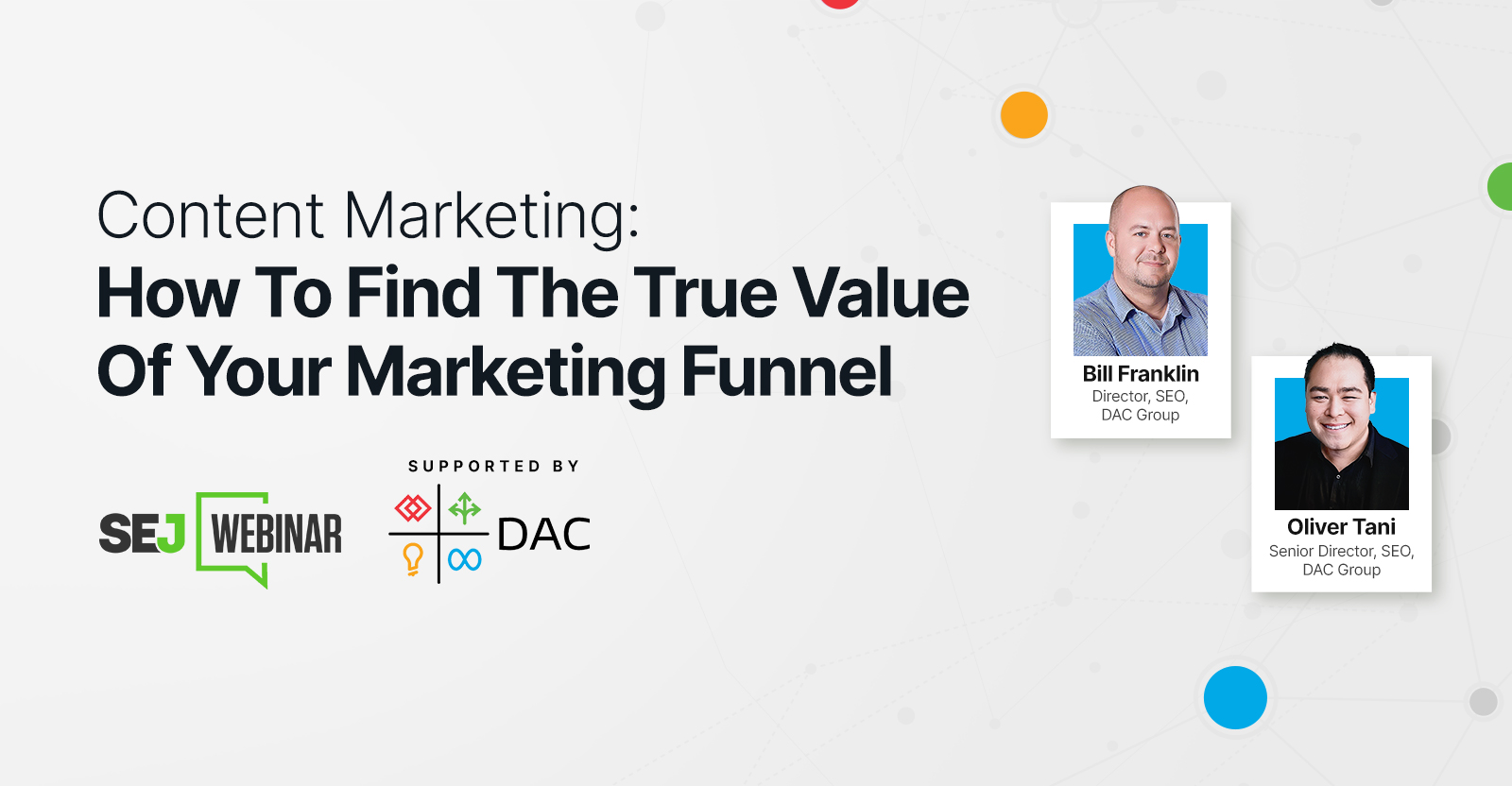
Understanding the impact of your content at every touchpoint of the customer journey is essential – but that’s easier said than done. From attracting potential leads to nurturing them into loyal customers, there are many touchpoints to look into.
So how do you identify and take advantage of these opportunities for growth?
Watch this on-demand webinar and learn a comprehensive approach for measuring the value of your content initiatives, so you can optimize resource allocation for maximum impact.
You’ll learn:
- Fresh methods for measuring your content’s impact.
- Fascinating insights using first-touch attribution, and how it differs from the usual last-touch perspective.
- Ways to persuade decision-makers to invest in more content by showcasing its value convincingly.
With Bill Franklin and Oliver Tani of DAC Group, we unravel the nuances of attribution modeling, emphasizing the significance of layering first-touch and last-touch attribution within your measurement strategy.
Check out these insights to help you craft compelling content tailored to each stage, using an approach rooted in first-hand experience to ensure your content resonates.
Whether you’re a seasoned marketer or new to content measurement, this webinar promises valuable insights and actionable tactics to elevate your SEO game and optimize your content initiatives for success.
View the slides below or check out the full webinar for all the details.
SEO
How to Find and Use Competitor Keywords

Competitor keywords are the keywords your rivals rank for in Google’s search results. They may rank organically or pay for Google Ads to rank in the paid results.
Knowing your competitors’ keywords is the easiest form of keyword research. If your competitors rank for or target particular keywords, it might be worth it for you to target them, too.
There is no way to see your competitors’ keywords without a tool like Ahrefs, which has a database of keywords and the sites that rank for them. As far as we know, Ahrefs has the biggest database of these keywords.
How to find all the keywords your competitor ranks for
- Go to Ahrefs’ Site Explorer
- Enter your competitor’s domain
- Go to the Organic keywords report
The report is sorted by traffic to show you the keywords sending your competitor the most visits. For example, Mailchimp gets most of its organic traffic from the keyword “mailchimp.”


Since you’re unlikely to rank for your competitor’s brand, you might want to exclude branded keywords from the report. You can do this by adding a Keyword > Doesn’t contain filter. In this example, we’ll filter out keywords containing “mailchimp” or any potential misspellings:
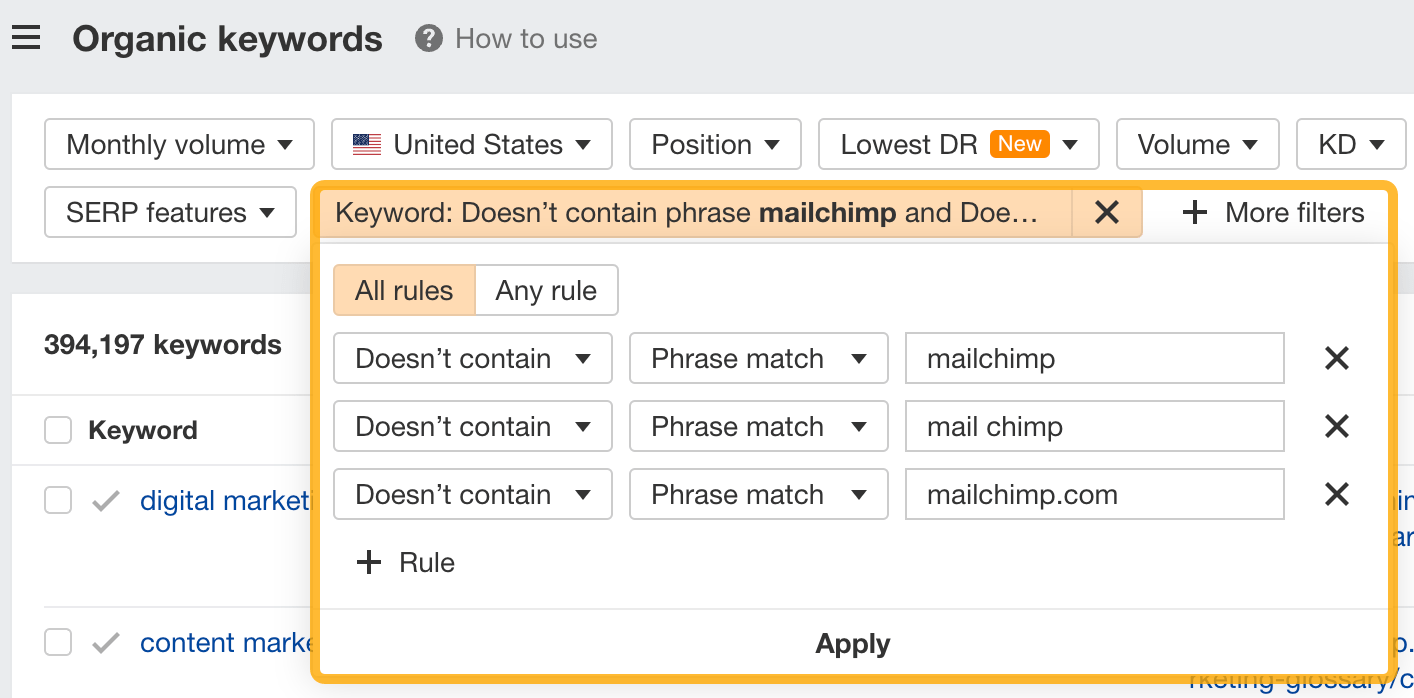

If you’re a new brand competing with one that’s established, you might also want to look for popular low-difficulty keywords. You can do this by setting the Volume filter to a minimum of 500 and the KD filter to a maximum of 10.


How to find keywords your competitor ranks for, but you don’t
- Go to Competitive Analysis
- Enter your domain in the This target doesn’t rank for section
- Enter your competitor’s domain in the But these competitors do section


Hit “Show keyword opportunities,” and you’ll see all the keywords your competitor ranks for, but you don’t.


You can also add a Volume and KD filter to find popular, low-difficulty keywords in this report.


How to find keywords multiple competitors rank for, but you don’t
- Go to Competitive Analysis
- Enter your domain in the This target doesn’t rank for section
- Enter the domains of multiple competitors in the But these competitors do section
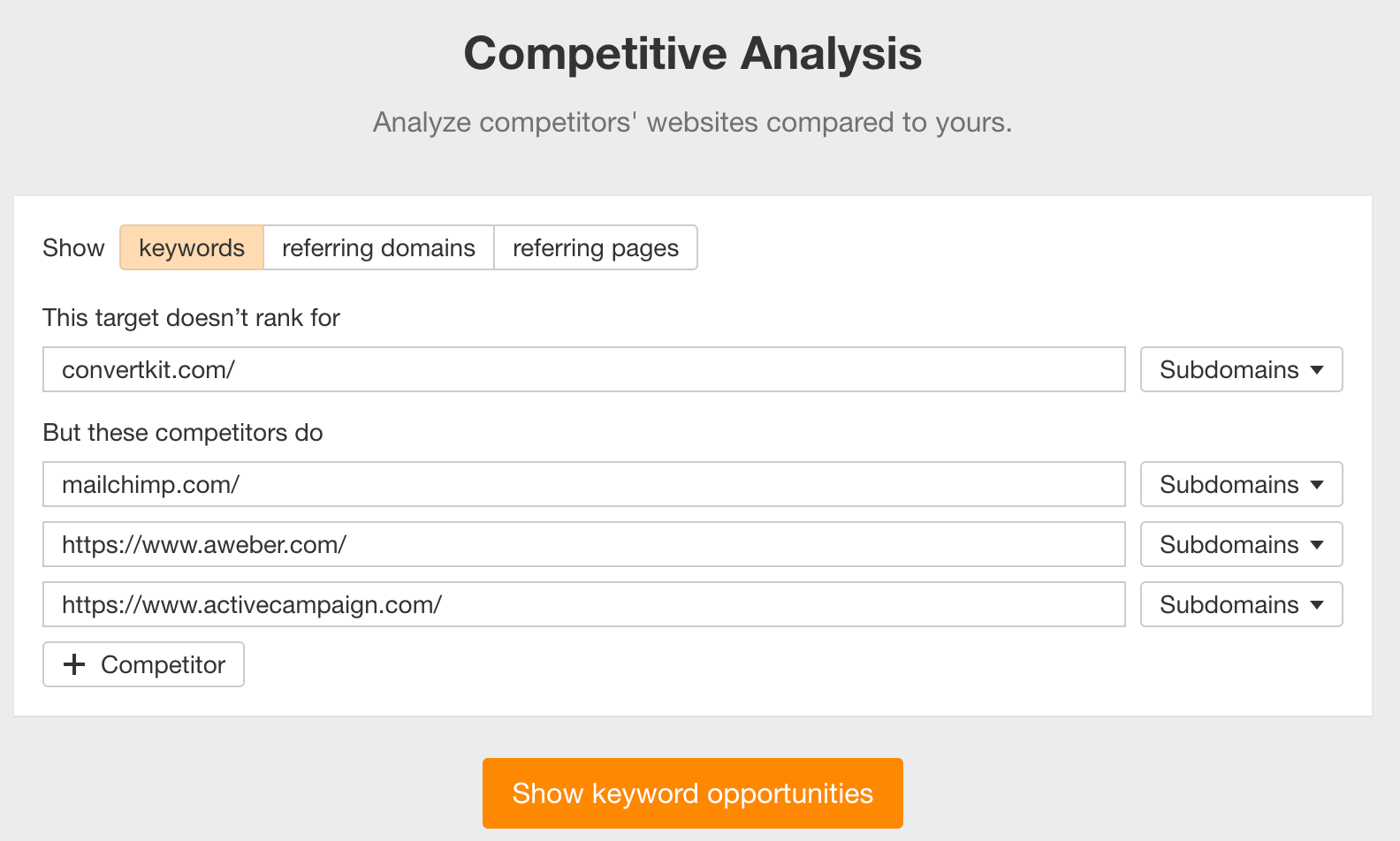

You’ll see all the keywords that at least one of these competitors ranks for, but you don’t.


You can also narrow the list down to keywords that all competitors rank for. Click on the Competitors’ positions filter and choose All 3 competitors:


- Go to Ahrefs’ Site Explorer
- Enter your competitor’s domain
- Go to the Paid keywords report
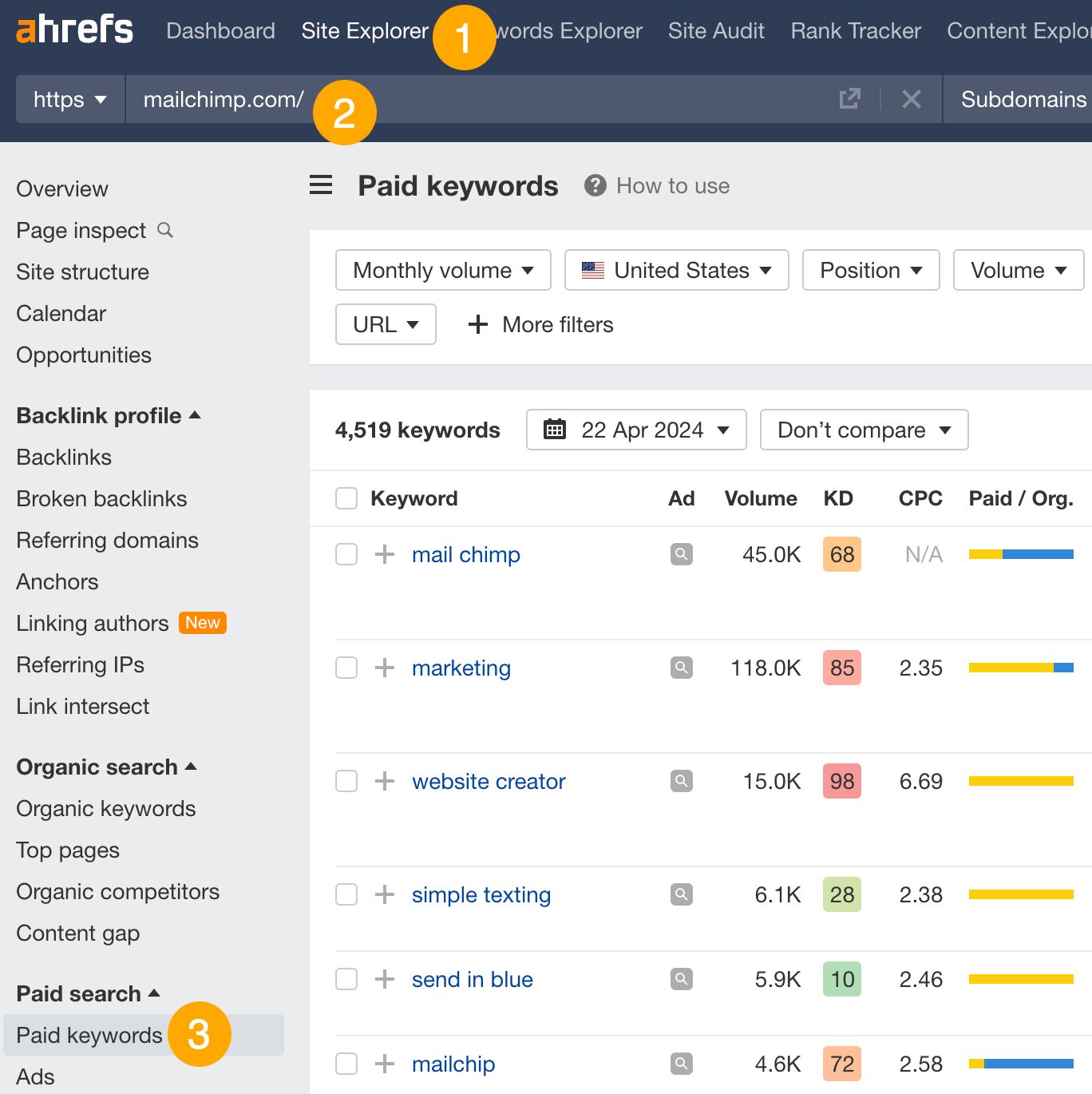

This report shows you the keywords your competitors are targeting via Google Ads.
Since your competitor is paying for traffic from these keywords, it may indicate that they’re profitable for them—and could be for you, too.
You know what keywords your competitors are ranking for or bidding on. But what do you do with them? There are basically three options.
1. Create pages to target these keywords
You can only rank for keywords if you have content about them. So, the most straightforward thing you can do for competitors’ keywords you want to rank for is to create pages to target them.
However, before you do this, it’s worth clustering your competitor’s keywords by Parent Topic. This will group keywords that mean the same or similar things so you can target them all with one page.
Here’s how to do that:
- Export your competitor’s keywords, either from the Organic Keywords or Content Gap report
- Paste them into Keywords Explorer
- Click the “Clusters by Parent Topic” tab


For example, MailChimp ranks for keywords like “what is digital marketing” and “digital marketing definition.” These and many others get clustered under the Parent Topic of “digital marketing” because people searching for them are all looking for the same thing: a definition of digital marketing. You only need to create one page to potentially rank for all these keywords.
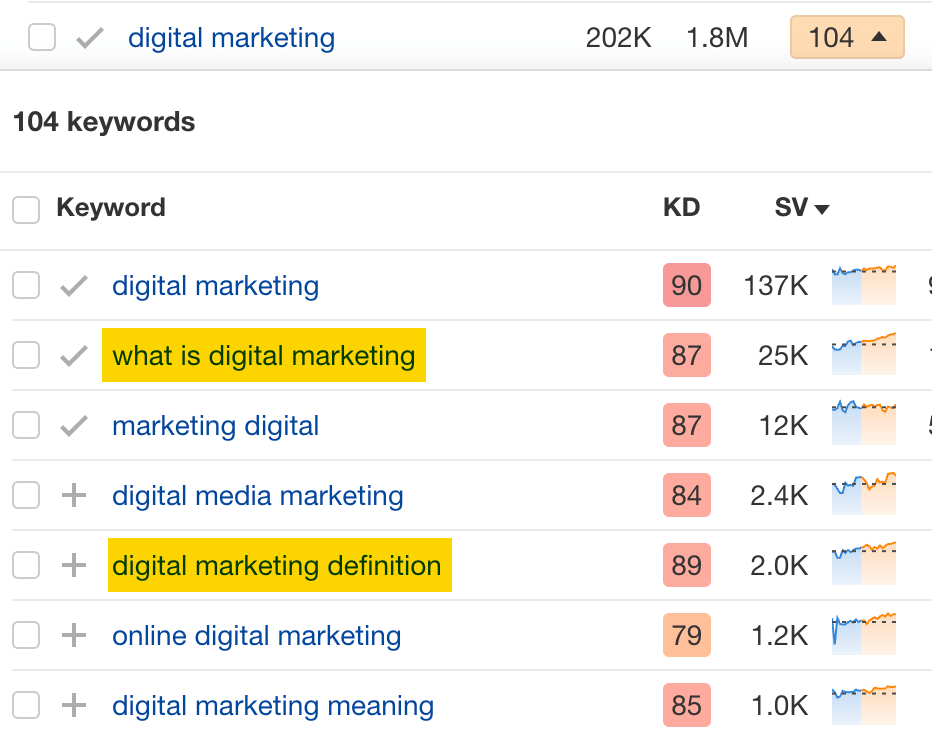

2. Optimize existing content by filling subtopics
You don’t always need to create new content to rank for competitors’ keywords. Sometimes, you can optimize the content you already have to rank for them.
How do you know which keywords you can do this for? Try this:
- Export your competitor’s keywords
- Paste them into Keywords Explorer
- Click the “Clusters by Parent Topic” tab
- Look for Parent Topics you already have content about
For example, if we analyze our competitor, we can see that seven keywords they rank for fall under the Parent Topic of “press release template.”


If we search our site, we see that we already have a page about this topic.


If we click the caret and check the keywords in the cluster, we see keywords like “press release example” and “press release format.”
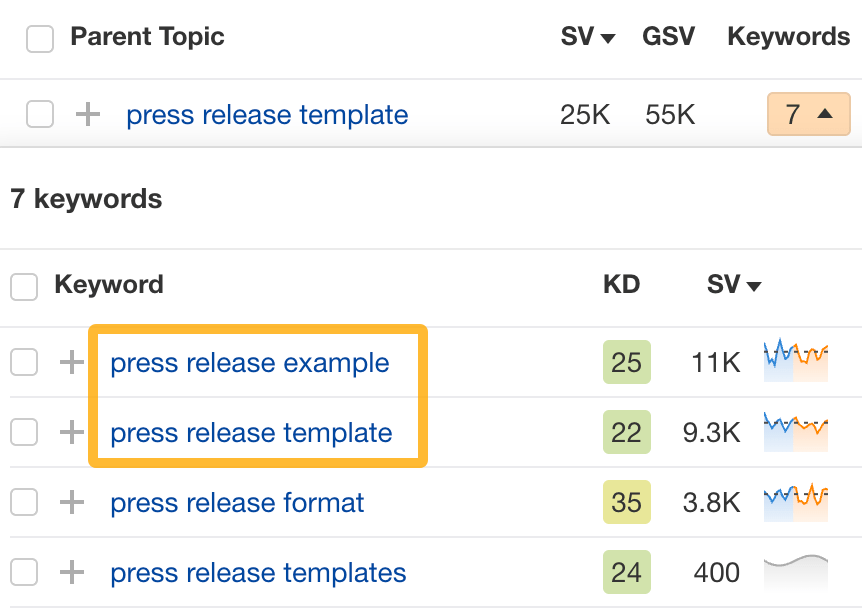

To rank for the keywords in the cluster, we can probably optimize the page we already have by adding sections about the subtopics of “press release examples” and “press release format.”
3. Target these keywords with Google Ads
Paid keywords are the simplest—look through the report and see if there are any relevant keywords you might want to target, too.
For example, Mailchimp is bidding for the keyword “how to create a newsletter.”


If you’re ConvertKit, you may also want to target this keyword since it’s relevant.
If you decide to target the same keyword via Google Ads, you can hover over the magnifying glass to see the ads your competitor is using.
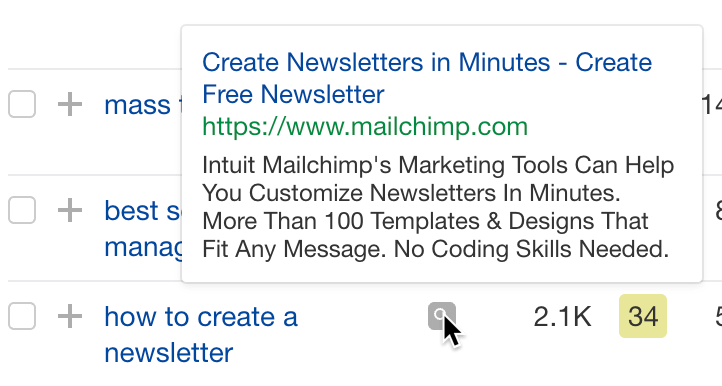

You can also see the landing page your competitor directs ad traffic to under the URL column.


Learn more
Check out more tutorials on how to do competitor keyword analysis:
SEO
Google Confirms Links Are Not That Important

Google’s Gary Illyes confirmed at a recent search marketing conference that Google needs very few links, adding to the growing body of evidence that publishers need to focus on other factors. Gary tweeted confirmation that he indeed say those words.
Background Of Links For Ranking
Links were discovered in the late 1990’s to be a good signal for search engines to use for validating how authoritative a website is and then Google discovered soon after that anchor text could be used to provide semantic signals about what a webpage was about.
One of the most important research papers was Authoritative Sources in a Hyperlinked Environment by Jon M. Kleinberg, published around 1998 (link to research paper at the end of the article). The main discovery of this research paper is that there is too many web pages and there was no objective way to filter search results for quality in order to rank web pages for a subjective idea of relevance.
The author of the research paper discovered that links could be used as an objective filter for authoritativeness.
Kleinberg wrote:
“To provide effective search methods under these conditions, one needs a way to filter, from among a huge collection of relevant pages, a small set of the most “authoritative” or ‘definitive’ ones.”
This is the most influential research paper on links because it kick-started more research on ways to use links beyond as an authority metric but as a subjective metric for relevance.
Objective is something factual. Subjective is something that’s closer to an opinion. The founders of Google discovered how to use the subjective opinions of the Internet as a relevance metric for what to rank in the search results.
What Larry Page and Sergey Brin discovered and shared in their research paper (The Anatomy of a Large-Scale Hypertextual Web Search Engine – link at end of this article) was that it was possible to harness the power of anchor text to determine the subjective opinion of relevance from actual humans. It was essentially crowdsourcing the opinions of millions of website expressed through the link structure between each webpage.
What Did Gary Illyes Say About Links In 2024?
At a recent search conference in Bulgaria, Google’s Gary Illyes made a comment about how Google doesn’t really need that many links and how Google has made links less important.
Patrick Stox tweeted about what he heard at the search conference:
” ‘We need very few links to rank pages… Over the years we’ve made links less important.’ @methode #serpconf2024″
Google’s Gary Illyes tweeted a confirmation of that statement:
“I shouldn’t have said that… I definitely shouldn’t have said that”
Why Links Matter Less
The initial state of anchor text when Google first used links for ranking purposes was absolutely non-spammy, which is why it was so useful. Hyperlinks were primarily used as a way to send traffic from one website to another website.
But by 2004 or 2005 Google was using statistical analysis to detect manipulated links, then around 2004 “powered-by” links in website footers stopped passing anchor text value, and by 2006 links close to the words “advertising” stopped passing link value, links from directories stopped passing ranking value and by 2012 Google deployed a massive link algorithm called Penguin that destroyed the rankings of likely millions of websites, many of which were using guest posting.
The link signal eventually became so bad that Google decided in 2019 to selectively use nofollow links for ranking purposes. Google’s Gary Illyes confirmed that the change to nofollow was made because of the link signal.
Google Explicitly Confirms That Links Matter Less
In 2023 Google’s Gary Illyes shared at a PubCon Austin that links were not even in the top 3 of ranking factors. Then in March 2024, coinciding with the March 2024 Core Algorithm Update, Google updated their spam policies documentation to downplay the importance of links for ranking purposes.
The documentation previously said:
“Google uses links as an important factor in determining the relevancy of web pages.”
The update to the documentation that mentioned links was updated to remove the word important.
Links are not just listed as just another factor:
“Google uses links as a factor in determining the relevancy of web pages.”
At the beginning of April Google’s John Mueller advised that there are more useful SEO activities to engage on than links.
Mueller explained:
“There are more important things for websites nowadays, and over-focusing on links will often result in you wasting your time doing things that don’t make your website better overall”
Finally, Gary Illyes explicitly said that Google needs very few links to rank webpages and confirmed it.
I shouldn’t have said that… I definitely shouldn’t have said that
— Gary 鯨理/경리 Illyes (so official, trust me) (@methode) April 19, 2024
Why Google Doesn’t Need Links
The reason why Google doesn’t need many links is likely because of the extent of AI and natural language undertanding that Google uses in their algorithms. Google must be highly confident in its algorithm to be able to explicitly say that they don’t need it.
Way back when Google implemented the nofollow into the algorithm there were many link builders who sold comment spam links who continued to lie that comment spam still worked. As someone who started link building at the very beginning of modern SEO (I was the moderator of the link building forum at the #1 SEO forum of that time), I can say with confidence that links have stopped playing much of a role in rankings beginning several years ago, which is why I stopped about five or six years ago.
Read the research papers
Authoritative Sources in a Hyperlinked Environment – Jon M. Kleinberg (PDF)
The Anatomy of a Large-Scale Hypertextual Web Search Engine
Featured Image by Shutterstock/RYO Alexandre
-

 PPC4 days ago
PPC4 days ago19 Best SEO Tools in 2024 (For Every Use Case)
-

 MARKETING7 days ago
MARKETING7 days agoWill Google Buy HubSpot? | Content Marketing Institute
-
SEARCHENGINES7 days ago
Daily Search Forum Recap: April 16, 2024
-

 SEO7 days ago
SEO7 days agoGoogle Clarifies Vacation Rental Structured Data
-

 MARKETING6 days ago
MARKETING6 days agoStreamlining Processes for Increased Efficiency and Results
-
SEARCHENGINES6 days ago
Daily Search Forum Recap: April 17, 2024
-

 SEO6 days ago
SEO6 days agoAn In-Depth Guide And Best Practices For Mobile SEO
-

 PPC6 days ago
PPC6 days ago97 Marvelous May Content Ideas for Blog Posts, Videos, & More















You must be logged in to post a comment Login